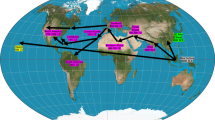Summary
Six cultivars of lucerne (Medicago sativa L.) were grown in all possible combinations with eight strains of Rhizobium meliloti in order to assess genetic variation in symbiotic nitrogen fixation. Host genotype and Rhizobium genotype effects on nitrogen fixation were respectively 4.8% and 21.0% of total phenotypic variance. Genetic variation due to host cultivar × Rhizobium strain interactions accounted for a further 6.0% of phenotypic variance. The results indicated low heritability of general symbiotic effectiveness in the host with interaction effects being large enough to suggest that plant performance may be unpredictable with populations of R. meliloti in field soils. Joint regression analysis showed that about 50% of the interactive variation could be explained by generalized differences in the sensitivity of cultivars to alterations in the genotype of Rhizobium strains. One cultivar, Siriver, was relatively insentitive to changes in the Rhizobium genotype whilst still maintaining high average yield. The implications of the results for lucerne breeding are discussed.
Similar content being viewed by others
References
Barnard C., 1969. Herbage plant species. CSIRO, Canberra. p. 86–87.
Barnard C., 1972. Register of Australian herbage plant cultivars. CSIRO, Melbourne. p. 184–185, 191–192.
Brockwell J., 1981. Can inoculant strains ever compete successfully with established soil populations? In: A. H. Gibson & W. E. Newton (Eds), Current perspectives in nitrogen fixation. Proc. 4th Int. Symp. on Nitrogen Fixation (Canberra) Aust. Acad. Sci., Canberra. p. 277
Brockwell J. & F. W. Hely, 1966. Symbiotic characteristics of Rhizobium meliloti: an appraisal of the systematic treatment of nodulation and nitrogen fixation interactions between hosts and rhizobia of diverse origins. Aust. J. Agric. Res. 17: 885–899.
Breese E. L., 1969. The measurement and significance of genotype-environment interactions in grasses. Heredity 31: 181–200.
Cooper, J. P., 1975. The control of photosynthetic production in terrestrial systems. In: J. P. Cooper (Ed.). Photosynthesis and productivity in different environments. IBP Vol. 3., pp. 593–621, Cambridge University Press.
Date R. A., 1969. A decade of legume inoculant quality control in Australia. J. Aust. Inst. Agric. Sci. 35: 27–37.
Dudman W. F. & J. Brockwell, 1968. Ecological studies of root-nodule bacteria introduced into field environments. I. A survey of field performance of clover inoculants by gel immune diffusion serology. Aust. J. Agric. Res. 19: 739–747.
Duhigg P., B. Melton & A. Baltensperger, 1978. Selection for acetylene reduction rates in ‘Mesilla’ alfalfa. Crop Sci. 18: 813–816.
Finlay K. W. & G. N. Wilkinson, 1963. The analysis of adaptation in a plant breeding programme. Aust. J. Agric. Res. 14: 742–754.
Gobson A. H., 1962. Genetic variation in the effectiveness of nodulation of lucerne varieties. Aust. J. Agric. Res. 13: 388–399.
Gibson A. H., 1980. Methods for legumes in glasshouses and controlled environment cabinets. In: F. J. Bergersen (Ed.), Methods for evaluating biological nitrogen fixation. Wiley, Chichester and New York. p. 139–184.
Hagedorn D. & B. A. Caldwell, 1981. Characterization of diverse Rhizobium trifolii isolates. Soil Sci. Soc. Am. J. 45: 513–516.
Hartley W., 1979. A checklist of economic plants in Australia. CSIRO, Melbourne. p. 65.
Heinrichs D. H., 1964. Developing creeping rooted alfalfa for pastures. Can. J. Agric. Sci. 34: 269–280.
Ireland J. A. & J. M. Vincent, 1968. A quantitative study of competition for nodule formation. Trans. 9th Int. Congr. Soil Sci. Soc. (Adelaide). Vol 2, p. 85–93.
Lehman, W. F., M. W. Nielson, V. L. Marble & E. H. Stanford, 1977. CUF101, a new variety of alfalfa is resistant to the blue alfalfa aphid. Calif. Agric. August 1977: 4–5.
Oram R. N., 1981. Register of Australian herbage plant cultivars. J. Aust. Inst. Agric. Sci. 46: 200–203.
Mytton L. R., 1975. Plant genotype × Rhizobiom strain interaction in white clover. Ann. Appl. Biol. 80: 103–107.
Mytton L. R., 1978. Some problems and potentialities in breeding for improved white clover-Rhizobium (Trifolium repens-Rhizobium trifolii) symbiosis. Ann. Appl. Biol. 88: 445–447.
Mytton L. R., M. H. El-Sherbeeny & D. A. Lawes, 1977. Symbiotic variability in Vicia faba. 3. Genetic effects of host plant, Rhizobium strain and of host × strain interaction. Euphytica 26: 785–791.
Snedecor G. W. & W. G. Cochran, 1967. Statistical methods, 6th ed. Iowa State U. Press, Ames.
Tan Geok-Yong, 1981. Genetic variation for acetylene reduction rate and other characters in alfalfa. Crop Sci. 21: 485–488.
Viands, D. R., D. K. Barnes & G. H. Heichel, 1981. Nitrogen fixation in alfalfa-responses to bidirectional selection for associated characteristics. U.S. Dep. Agric., Agric. Res. Serv., Tech. Bull. No. 1643.
Author information
Authors and Affiliations
Rights and permissions
About this article
Cite this article
Mytton, L.R., Brockwell, J. & Gibson, A.H. The potential for breeding an improved lucerne-rhizobium symbiosis. 1. Assessment of genetic variation. Euphytica 33, 401–410 (1984). https://doi.org/10.1007/BF00021137
Received:
Issue Date:
DOI: https://doi.org/10.1007/BF00021137




